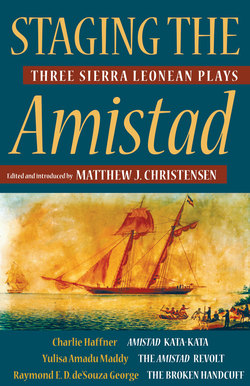Читать книгу Staging the Amistad - Charlie Haffner - Страница 8
На сайте Литреса книга снята с продажи.
ОглавлениеTimeline
| 16th century | Transatlantic slave trade begins along the Upper Guinea Coast. |
| 1787 | “Province of Freedom,” near today’s Freetown, first settled by “Black Poor” liberated slaves living in England. |
| 1792 | Freetown established by second wave of liberated slaves from the Americas. |
| 1808 | Sierra Leone declared a British Crown Colony. |
| 1808–17 | Major Atlantic powers sign treaties to abolish transatlantic slave trade. |
| 1808–60 | British naval patrols enforcing treaties settle Africans liberated from illegal slaving vessels in Freetown regardless of their origin. |
| Apr. 1839 | Slave ship Teçora sets sail from Lomboko carrying Sengbe Pieh and other Amistad rebels to Cuba. Slave factories around Lomboko were sending about 2,000 Africans per year to the Americas at this time. |
| June 28, 1839 | Carrying Sengbe Pieh and other Amistad rebels, La Amistad departs Havana for Puerto Principe. |
| July 1, 1839 | Amistad rebellion, followed by two months at sea. |
| Aug. 26, 1839 | Lt. Gedney and crew of USS Washington take command of the Amistad. |
| Sept. 1839–Sept. 1849 | Amistad-focused District and Circuit Court trials. |
| Mar. 9, 1841 | Supreme Court rules in favor of the Amistad rebels. |
| Nov. 1841–Jan. 1842 | The Gentleman returns the surviving Amistads and members of the American Missionary Society to Sierra Leone. |
| 1898 | Bai Bureh leads war in opposition to British efforts to assert colonial control of areas outside Freetown. |
| 1920s–1950s | Period marked by increasing anticolonial nationalist demands for political independence. |
| Apr. 27, 1961 | Sierra Leone gains political independence from British colonial rule. Milton Margai named first prime minister. |
| 1978 | Siaka Stevens declares one-party rule. Period marked by global economic crises, political misrule, and increasing culture of corruption, which lead to a long period of economic decline. |
| 1985 | Stevens’s handpicked successor Joseph Saidu Momoh elected president; Momoh welcomes International Monetary Fund reforms; economy continues to erode. |
| 1988 | Charlie Haffner debuts Amistad Kata-Kata in Freetown at the British Council auditorium. |
| Mar. 23, 1991 | The Revolutionary United Front/Sierra Leone (RUF/SL) launches first armed attacks in southern Sierra Leone, initiating a decade-long war. |
| Apr. 29, 1992 | Military coup topples Momoh’s government; widespread optimism that military government will bring a quick end to the war. |
| 1993 | Grassroots art movement makes Amistad revolt leader Sengbe Pieh a central icon in public murals designed to foster national pride in opposition to RUF/SL. |
| 1993 | Yulisa Amadu Maddy debuts The Amistad Revolt at the University of Iowa. |
| 1994 | Raymond de’Souza George debuts The Broken Handcuff in Freetown at the British Council auditorium. |
| Jan. 18, 2002 | The war is declared over and disarmament complete. |
